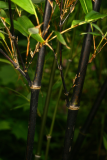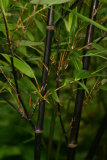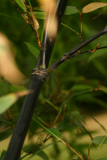Additional notes (click to expand)
Medicinal
In traditional herbal medicine:
The leaves are antipyretic and diuretic. They are used internally in the treatment of fevers (especially infantile convulsions), vomiting and nosebleeds. The leave are harvested during the growing season and dried for later use. The juice of the stems is antipyretic, antitussive, expectorant and sedative. It is taken internally in the treatment of lung infections with cough and phlegm. The sap is pressed from young stems in the summer and then dried for later use. The epidermis of the stem bark is antiemetic, depurative and sedative. It is used internally in the treatment of vomiting, nosebleeds, coughs etc. The epidermis is collected from young stems in the summer and is dried for later use. The root is astringent, antipyretic, diuretic and styptic. It has been used in the treatment of rabies. The roots are harvested in the winter and dried for later use.
Duke. J. A. and Ayensu. E. S. Medicinal Plants of China Reference Publications, Inc. 1985
Bown. D. Encyclopaedia of Herbs and their Uses. Dorling Kindersley, London. 1995
http://www.pfaf.org, https://pfaf.org/user/Plant.aspx?LatinName=Phyllostachys+nigra
Other use
Long cultivated in Japan for the canes, used as walking sticks, umbrella handles, musical instruments, furniture etc.
Mabberley, D.J. (1997) The Plant Book, ed.2, Cambridge University Press 552
Geographical distribution
- Asia-Temperate, China
Phyllostachys nigra (Lodd. ex Lindl.) Munro
Family: POACEAEGenus: Phyllostachys
Species: nigra (Lodd. ex Lindl.) Munro
Common names: Black Bamboo, Whangee Cane
Distribution summary: China
Habit: Shrub
Hardiness: H5 - Hardy; cold winter
Habitat: Moist woodland and riverbanks
Garden status: Currently grown
Garden location: Far East (L)
Reason for growing: Medicinal, other use



